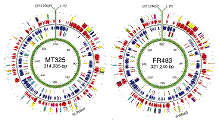Virology, Nebraska Center for
Document Type
Article
Date of this Version
2012
Citation
Published in PLoS ONE (2012) 7(8): e43317. DOI:10.1371/journal.pone.0043317
Abstract
Epstein-Barr virus (EBV) is a ubiquitous human herpesvirus. Toll-like receptor 7 (TLR7) is involved in host innate immunity against pathogens, and its aberrant activation is linked to the development of systemic lupus erythematosus (SLE, also called ‘‘lupus’’). Type I interferons (IFN) are apparently driving forces for lupus pathogenesis. Previously, we found that EBV latent membrane protein 1 (LMP1) primes cells for IFN production. In this report, the relationship among EBV LMP1, TLRs, and IFN production are examined. We find that TLR7 activation increases the expression of EBV LMP1, and IFN regulatory factor 7 (IRF7) is involved in the stimulation process. TLR7 activation did not induce IFNs from EBV-infected cells, but potentiates those cells for IFN production by TLR3 or TLR9 activation. In addition, we find that LMP1 and IFNs are coexpressed in the same cells in some lupus patients. Therefore, the aberrant activation of TLR7 might induce LMP1 expression and LMP1-expression cells may be producing IFNs in lupus patients. These results suggest EBV might be an exacerbating factor in some lupus patients via promoting IFN production.


Comments
Copyright © 2012 Valente et al.